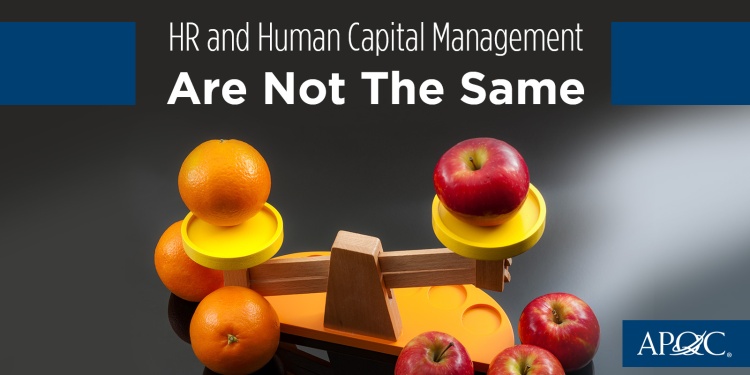
I have spent my entire career working in the HR space and I often see the terms HR and human capital management (HCM) used interchangeably. In fact, I am guilty of using these terms interchangeably. Perhaps as a result, members ask APQC: What is the difference between HR and human capital management?
In this blog, I explain what human capital management is and how it differs from HR. Then, I reveal HR and human capital management best practices and challenges identified via APQC research. At the end of the post, I share links to resources that can help you address HR and HCM challenges that your organization may face.
Human Capital Management (HCM) is the practice of managing talent in ways that enable an organization to reach its strategic objectives. APQC’s Process Classification Framework®, a common taxonomy of business processes, includes the following process groups as part of human capital management (PCF category 7.0):
- 7.1 Developing and managing human resources planning, policies, and strategies
- 7.2 Recruiting, sourcing, and selecting employees
- 7.3 Managing onboarding, training, and development
- 7.4 Managing employee relations
- 7.5 Rewarding and retaining employees
- 7.6 Redeploying and retiring employees
- 7.7 Managing employee information and analytics
- 7.8 Managing employee communications
Human Resources (HR) is the organizational function with accountability for HCM (PCF category 7.0). HR leads the organization in managing talent to enable business objectives—from developing HR strategies (process group 7.1) to managing employee communications (process group 7.8). In addition to HR, business leaders and managers have human capital management responsibilities.
HR Function Best Practices
APQC research has revealed practices that differentiate best-in-class HR functions. These include:
Strategy
- Tightly aligning HR strategy with business strategy
- Having HR take an active role in contributing to the business strategy
Structure
- Aligning HR function structure with business structure
- Centralizing HR to at least some extent
- Leveraging HR business partners, centers of expertise, and HR shared services
Staff
- Providing robust HR development across HR career stages
- Building analytics, cost management, and HR expertise among HR staff
- Fostering collaboration across HR
Process
- Standardizing, integrating, and, where applicable, automating HR processes
- Making fit with HR processes a key factor in HR technology purchase decisions
Technology
- Using technology to improve how HR gets work done
- Integrating HR technologies
Analytics
- Using prescriptive and predictive analytics
- Making data-informed HR decisions
Human Capital Management Keys to Success
APQC research has also uncovered many keys to overall HCM success—to overall success with PCF category 7.0. These include:
- Having senior managers understand the importance of HCM to business results
- Creating formal business cases for new HCM initiatives
- Formally assigning accountabilities and responsibilities for implementing HCM initiatives
- Including business leaders as responsible for HCM initiatives where appropriate
- Using measures to evaluate and communicate HCM outcomes
- Using employee surveys to inform and evaluate HCM
- Working to assess and communicate the return on human capital investments
Common HR and HCM Challenges
HR leaders responding to APQC’s Open Standards Benchmarking® Talent Management Performance Assessment told APQC that the following are their top challenges.
- Retaining talent/reducing turnover
- Attracting and recruiting talent
- Managing employee relations
- Developing leadership
- Transforming HR into a strategic partner in the business
- Managing a globally diverse workforce
- Creating effective employee learning programs
- Designing engaging employee experiences
- Effectively using analytics to inform HR strategy
- Managing an aging workforce
- Managing employee data security and privacy
Most of these are HCM challenges that HR will take the lead in tackling with participation from the broader organization. Transforming HR into a strategic business partner, however, is an HR function challenge—and one that our research shows HR has been steadily making progress on for a number of years now.
APQC members have access to resources that provide guidance for addressing these common HR and HCM challenges, including our collections on Human Capital Management Best Practices and Best-in-Class HR Functions.
Not an APQC member? Here is a sampling of improvement resources that are available to all as part of APQC’s mission to help organizations around the world improve productivity and quality by discovering effective methods of improvement, broadly disseminating findings, and connecting individuals with one another and with the knowledge they need to improve.
12 Keys to Success: HCM Strategies that Get Business Results
Boosting New Employee Retention
Internal Promotion Rate for Leadership Positions